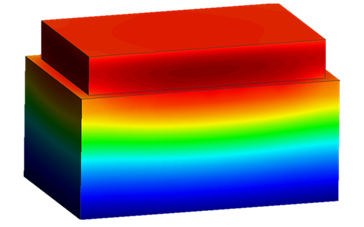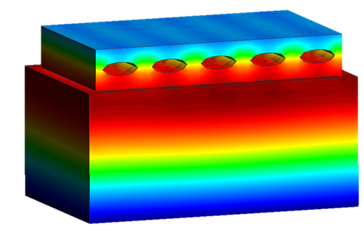Ceramic, Simulation
MODELING OF THE ENERGY SAVING OF A BLOCK OF R-COR-S SUBJECT TO A THERMAL CYCLE OF 20 HOURS.
The technical department of TEIDE REFRACTORY SOLUTIONS, S.L., has been able to quantify by the HEATEIDE the energy saving that involves the use of alveolar blocks instead of the solid ones in the base of the wagon.
At the time of the simulation, the two geometries and one section of the kiln car, have been studied, in order to be able to quantify the best way of using one or another.
Following the two studied geometries:
Below are shown profiles of temperature to 4, 16 and 20 hours from the beginning of the cycle. T= 4h
-
Piece A
-
Piece B
T = 16h (end of the heating cycle)
-
Piece A
-
Piece B
T = 20h (output of the kiln car tunnel)
-
Piece A
-
Piece B
Following are shown the temperature profiles of both sizes: cold and inter face one, between deck block and the kiln car.
Cold face’s profiles: It can be seen that in case of alveolar piece, the temperature is lower at all the time, reaching it’s maximum difference at the end of the cycle. The difference in temperature (Tº) in this point is 10ºC.
Inter face’s profiles:
In the previous graph is shown that in range 12-16 hours, the temperature falls down 50ºC using the alveolar geometry.
Analyzing the two graphs at he same time, let us to expose that there is an energy saving using the alveolar piece, since for the same ramp, the accumulated heat in the studied set will be lower. Below is numerically shown that the lower analyzed value (previously these lines) affects in an important energy saving.
Analyzing with the HEATEIDE module, the incoming and the outgoing heat flows, it can be obtained the values of net energy in each of the studied cases.
In the following table it is shown the accumulated heat as per (m2):
Now is turn to quantify the energy saving, taking into consideration the following kiln car size: 5,14 m x 2,9 m = 14,9 m2
Analyzing the percentage of the energy saving provided by the simple replacement of alveolar pieces instead of solid ones, is around 21%.
Taking into account that the energy saving per kiln car is 90 KWh, assuming that from the kiln car tunnel 40 KWh, the economic annual savings using the alveolar blocks is the exposed below:
Analyzing the total balance sheet of the kiln car tunnel, this 21% reduction of accumulated heat in the kiln car reports savings in other factors like lower energy input from the burners, decrease in exhaust, less loss between joints, etc., making these savings will be higher in the overall balance of the kiln car tunnel.











